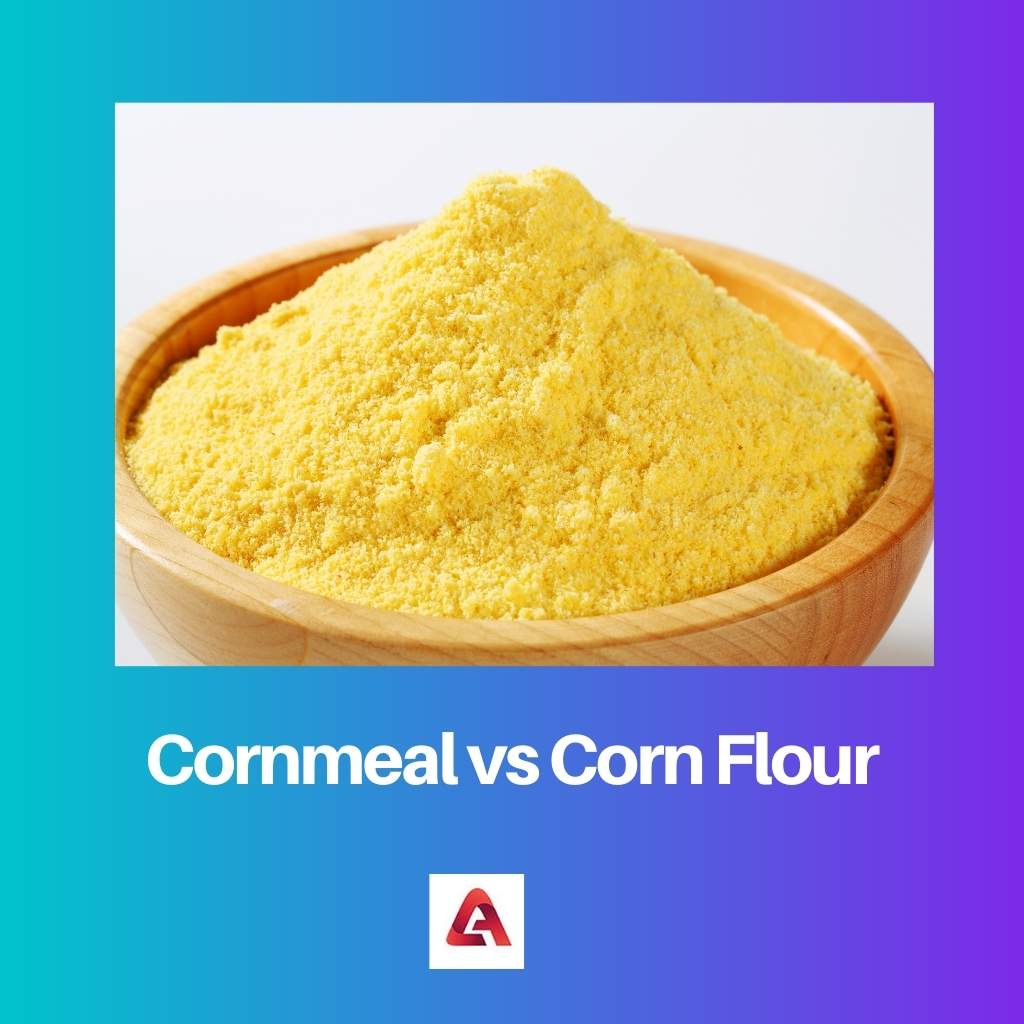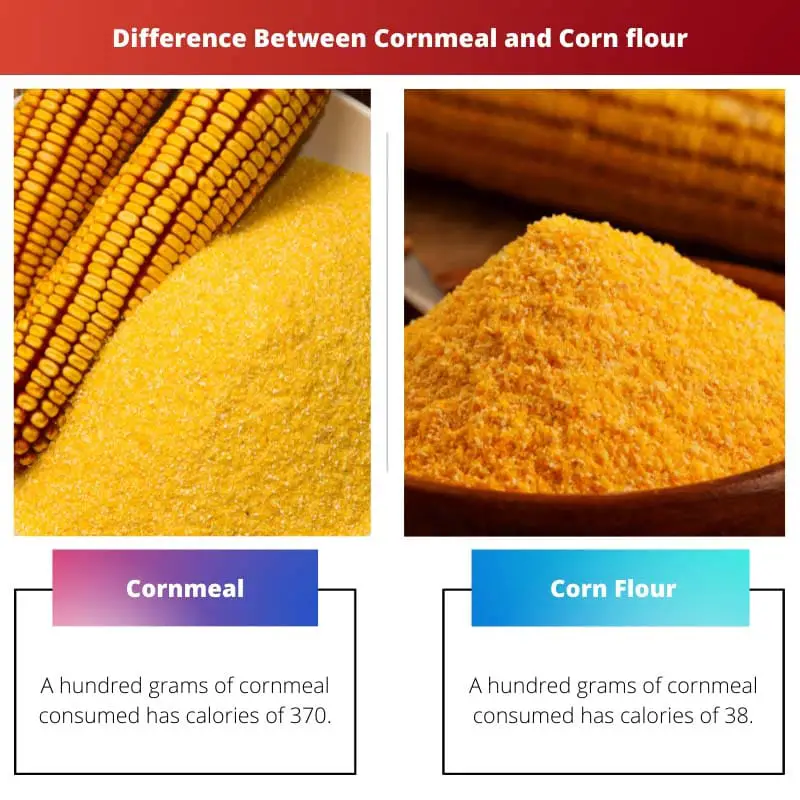Cornmeal and corn flour are derived from the vegetable called corn. It is a starchy vegetable that is eaten in different ways.
The difference between cornmeal and corn flour is that they differ in their texture. They are also used for different purposes.
Both differ in their nutritional values, nutrients and carbohydrates.
Key Takeaways
- Cornmeal is coarser in texture compared to the fine consistency of corn flour.
- Corn flour is a thickening agent in recipes, while cornmeal is used for baking and making dishes like cornbread and polenta.
- Both cornmeal and corn flour are gluten-free and made from ground corn, but they serve different purposes in cooking.
Cornmeal vs Corn Flour
Cornmeal feels gritty, while corn flour is fine and smooth. Corn flour is finely ground, and Cornmeal is coarsely ground. Cornmeal can be eaten by itself once boiled and used in bread or pastry, while corn flour is used for baking.

Cornmeal is procured from dried corn. It is eaten as a meal.it is also a staple food.
People belonging to various cultures use cornmeal to make porridge. This cornmeal is called Polenta in Italy and Sadza in Zimbabwe.
In Mexico, the cornmeal which is finely ground is called corn flour.
Corn flour has also been referred to as corn starch and maize starch. The endosperm present in the Kernel is where the starch is.
Corn flour is used to thicken soups and sauces. It is a very common ingredient in the kitchen.
It is also used to make corn syrup and various other sugars.
Comparison Table
| Parameters of Comparison | Cornmeal | Cornflour |
|---|---|---|
| Calories | A hundred grams of cornmeal consumed has calories of 370 | A hundred grams of cornmeal consumed has calories of 381 |
| Potassium | For a hundred grams of cornmeal consumed, it has 142 milligrams of potassium. | For every hundred grams of cornflour consumed it has 3 milligrams of potassium. |
| Sodium | For a hundred grams of cornmeal consumed, it has 7 milligrams of potassium. | For every hundred grams of cornflour consumed it has 9 milligrams of sodium. |
| Origin | It is made from grounding the dried yellow corn. | It is derived from the endosperm of the kernel. |
| Mostly used for | Cornmeal is mostly used to make porridge. | Cornflour is used to thicken soups and sauces. |
What is Cornmeal?
The yellow dried corn is ground to get cornmeal. It is grounded in coarse or medium and fine consistency, based on whatever you require.
The cornmeal which is boiled is called Polenta in Italy. In Romania, this is a traditional dish, and it is also used as a substitute for bread.
The same cornmeal, when grounded finely and obtained from maize, is soaked in an alkaline solution such as lime water. This process is called nixtamalization.
This is used to make areas, tortillas and tamales. This is also called “masa harina.”
There are also various types of cornmeal.
From the blue corn, blue cornmeal is derived. It is violet or light blue.
It has a sweet flavour to it. The yellow colour cornmeal, which is steel ground, is widely used in the United States.
White cornmeal is used in Africa. In the Southern United States, white cornmeal is used to make cornbread.
Cornmeal is widely used in Jamaica as a break porridge. In East Asia, this porridge is consumed with pickles.
Cornmeal is a good source of fibre and protein. It is rich in complex carbohydrates.

What is Corn Flour?
Corn flour is a starch that is derived from corn or Maize. This starch is present in the endosperm of the Kernel.
Cornflour is also called cornstarch and maize starch. It is not just a food ingredient but is used in industries such as adhesives and textile manufacturing.
It is used in paper products as an anti-sticking agent. It is used in the medical industry as well.
For people who have glycogen storage disease, cornflour is used to supply glucose. Corn starch is in the consistency of a powder.
It has protein, fats, potassium, vitamin A, and carbohydrates.
Corn starch is used as a thickening agent in the culinary industry, such as soups, gravies and much more. In powdered sugar, it is used as an anticaking agent.
It is also added to yoghurt and cheese in varying amounts. For non-culinary purposes, cornstarch is also included in baby powders.
The steeping process takes place from thirty to forty-eight hours. The corn is steeped, which helps it to ferment.
Here the starch will be separated from corn steep liquor and dried. This is called wet milling.
| # | Preview | Product | |
|---|---|---|---|
| 1 |

| Bob's Red Mill Corn Flour 22 ounce (Pack of 1) | Check Price on Amazon |
| 2 |

| Bob's Red Mill Organic Corn Flour, 22 Oz | Check Price on Amazon |

Main Differences Between Cornmeal and Corn flour
- Cornmeal and corn flour differ in their texture. Cornmeal is grounded coarsely or finely. Corn flour is more of a powdered consistency that is mixed with water to make a thick paste. Cornmeal is also finely grounded, but it does not become starch like corn flour. Both the cornmeal and corn flour consistency also is different.
- Cornmeal is obtained from dried corn. It is grounded according to the consistency of the dish’s requirements. It is also soaked in lime water, and then it is utilized to make tortillas, tamales etc. Cornstarch is obtained from the starch of the Kernel present in corn. Because of its starchy ability, it is primarily used as a thickening agent.
- Cornmeal and cornstarch differ in their nutritional values and carbs. For a hundred grams of cornmeal, it is 370 calories and for a hundred grams of cornstarch, it is 381 calories. Cornmeal porridge is rich in fibre, thiamin, riboflavin, niacin and iron.
- Cornstarch is used for culinary purposes to thicken sauces and for non-culinary purposes as an adhesive. But cornmeal is only a culinary ingredient.
- Cornstarch is used in medical fields, but cornmeal is not utilized there.

- https://www.ncbi.nlm.nih.gov/pmc/articles/pmc4260129/
- https://www.ncbi.nlm.nih.gov/pmc/articles/pmc4260132/



This article definitely opened my eyes to the various applications of cornmeal and corn flour. It’s great to learn that they have such distinguished uses across different cultures.
Yes, the cultural context really adds depth to the information presented. It’s wonderful to know the diverse roles of these ingredients.
I appreciate the in-depth information provided here with regard to both cornmeal and corn flour. It’s enlightening to see the extensive uses of these food items.
This article is definitely a treasure trove of knowledge, especially for those with an interest in cooking or cultural studies.
The article is very informative and goes into great detail about the differences between cornmeal and corn flour. I had no idea how different they were. This is definitely a great read for those wanting to expand their culinary horizons.
I’m surprised by the vast nutritional differences between the two. This is definitely good to know when cooking or trying to maintain a balanced diet.
Yes, it’s surprising how many different uses there are for these two ingredients. Very interesting read.
The detailed explanations about the uses of cornmeal and corn flour are quite fascinating. This article provides a deep insight into the culinary world.
Absolutely, and the historical and cultural references are a great addition. This article is truly a rich source of knowledge.
The detailed breakdown of different types of cornmeal and its uses in various cuisines is quite intriguing. It’s amazing to see how these staples have evolved over time and across regions.
Absolutely, and the article provides a comprehensive look at the historical and cultural significance behind these ingredients.
The historical and cultural context provided in this article adds a rich layer of understanding to the uses of cornmeal and corn flour. I found it to be quite enlightening.
Absolutely, this article is a wonderful resource for exploring the culinary heritage associated with these ingredients.
This article provides a comprehensive understanding of cornmeal and corn flour from both scientific and cultural perspectives. It’s an insightful read for anyone with an interest in food studies.
I completely agree, this article truly explores the depths of culinary knowledge. It’s both enlightening and inspiring.
Absolutely, this level of detail is commendable. It’s a fantastic reference for both traditional and contemporary culinary uses.
This article provides a lot of useful information about cornmeal and corn flour, especially when considering dietary concerns or cooking applications.
Absolutely, the article really delves into the versatility of cornmeal and corn flour. I’m taking away a lot of knowledge from this.
I found it particularly interesting to learn about the origins and traditional uses of cornmeal in various cultures.
The comparison table is particularly helpful in understanding the differences between cornmeal and corn flour. This level of detail is much appreciated.
I agree, having a clear breakdown of the nutritional aspects is very insightful. It’s a great resource for anyone interested in cooking or nutrition.
The detailed nutritional comparison and uses of cornmeal and corn flour are particularly fascinating. This article is a valuable resource for anyone interested in food science.
Absolutely, the level of detail here is really impressive. It’s a great reference for those looking to explore the culinary world.
The health and dietary information provided here is truly valuable. It’s great to know the nuanced aspects of these ingredients.